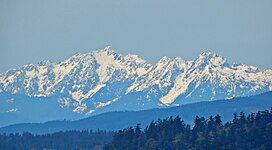Mount Pershing is a 6,154-foot-elevation (1,876-meter) massif in Mason County of Washington state, United States.[4] Part of the Olympic Mountains, it is situated in the Mount Skokomish Wilderness on land managed by Olympic National Forest. The mountain's toponym honors General of the Armies John J. Pershing (1860–1948).[5] The nearest higher neighbor is Mount Washington, 1.45 mi (2.33 km) to the south-southeast.[1] Precipitation runoff from its slopes drains into the Hamma Hamma River.
| Mount Pershing | |
|---|---|
 Mount Pershing (left) seen from West Seattle (Jefferson Peak to the right) | |
| Highest point | |
| Elevation | 6,154 ft (1,876 m)[1] |
| Prominence | 1,114 ft (340 m)[1] |
| Parent peak | Mount Washington (6,260 ft)[2] |
| Isolation | 1.53 mi (2.46 km)[2] |
| Coordinates | 47°33′08″N 123°15′22″W / 47.552125°N 123.255973°W[1] |
| Naming | |
| Etymology | John J. Pershing |
| Geography | |
| Country | United States |
| State | Washington |
| County | Mason |
| Protected area | Mount Skokomish Wilderness |
| Parent range | Olympic Mountains |
| Topo map | USGS Mount Skokomish |
| Geology | |
| Rock age | Eocene |
| Rock type | pillow basalt |
| Climbing | |
| First ascent | 1939 by Don Dooley, Robert Henderson, Walt Ingalls, and Bob Mandelhorn[3] |
| Easiest route | class 3 scrambling via South Ridge[3] |
Climate
editMount Pershing is located in the marine west coast climate zone of western North America.[6] Weather fronts originating in the Pacific Ocean travel northeast toward the Olympic Mountains. As fronts approach, they are forced upward by the peaks (orographic lift), causing them to drop their moisture in the form of rain or snow. As a result, the Olympics experience high precipitation, especially during the winter months in the form of snowfall.[7] Because of maritime influence, snow tends to be wet and heavy, resulting in avalanche danger. During winter months weather is usually cloudy, but due to high pressure systems over the Pacific Ocean that intensify during summer months, there is often little or no cloud cover during the summer.[7] The months May through August offer the most favorable weather for viewing or climbing this mountain.[3]
Geology
editThe Olympic Mountains are composed of obducted clastic wedge material and oceanic crust, primarily Eocene sandstone, turbidite, and basaltic oceanic crust.[8] The mountains were sculpted during the Pleistocene era by erosion and glaciers advancing and retreating multiple times.
Gallery
editSee also
editReferences
edit- ^ a b c d "Mount Pershing". Peakbagger.com.
- ^ a b "Pershing, Mount - 6,154' WA". listsofjohn.com. Retrieved 2022-01-08.
- ^ a b c Mount Pershing, climbersguideolympics.com
- ^ "Mount Pershing". Geographic Names Information System. United States Geological Survey, United States Department of the Interior. Retrieved 2018-08-03.
- ^ Olympic Mountain Rescue, Olympic Mountains: A Climbing Guide, 4th Edition, 2006, Mountaineers Books, ISBN 9780898862065, page 60.
- ^ Peel, M. C.; Finlayson, B. L.; McMahon, T. A. (2007). "Updated world map of the Köppen−Geiger climate classification". Hydrol. Earth Syst. Sci. 11: 1633–1644. ISSN 1027-5606.
- ^ a b McNulty, Tim (2009). Olympic National Park: A Natural History. Seattle, Washington: University of Washington Press.
- ^ Alt, D.D.; Hyndman, D.W. (1984). Roadside Geology of Washington. pp. 249–259. ISBN 0-87842-160-2.
External links
edit- Weather forecast: Mount Pershing
- Mount Skokomish Wilderness U.S. Forest Service
- Mts. Pershing and Washington photo: Flickr

